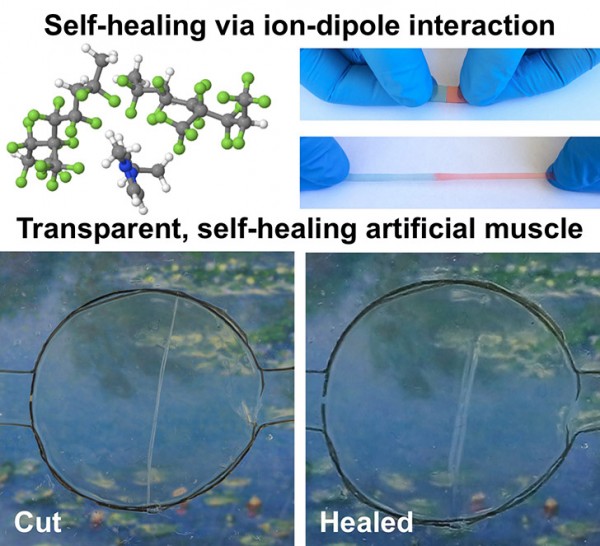In an article published in the December 25th, local time, "Advanced Materials" magazine introduced a transparent and highly extensible guideline developed by Wang Chao, a scientist at the University of California, Riverside, and colleagues to develop a self-healing capability. Ionic materials. This material can give robots the ability to heal themselves after a mechanical failure, prolong the service life of electric vehicles and lithium-ion batteries, and improve the performance of biosensors in medical and environmental monitoring. For the first time, the new study "combines self-healing materials with ionic conductors."

The new material can be made into a transparent artificial muscle with self-healing function. Image Source: University of California, Riverside
Self-healing materials can automatically repair the loss caused by use, prolong service life and reduce costs; and ion conductors that allow ions to flow in them play an important role in energy storage, solar energy conversion, sensors and electronic devices. Wang Chao said: "The research and development of a variety of superior materials in a single material is a problem that has not been solved by the scientific community for many years. Now we have succeeded and have begun to develop its related applications."
The ion conductor previously developed by the author of the paper and associate professor Christopher Keplinger of the University of Colorado Boulder can supply artificial muscles and use it as a transparent speaker, but it cannot cure itself after a mechanical failure. The reason for the inability to self-heal is that the covalent bonds contained in these polymers react in an electrochemical environment, reducing the properties of the material. Wang Chao used ion dipoles to couple between charged ions and polar molecules, which greatly improved the stability of ion conductors. He eventually developed a new type of self-healing material that combines various superior properties.
This rubber-based soft material is low in cost, easy to produce, and can be extended to 50 times the original length. When sheared, they can be reconnected (self-healing) within 24 hours at room temperature, and can be re-expanded again in only 5 minutes after self-healing.
Wang Chao team also uses new materials to develop new artificial muscles. This artificial muscle consists of three layers of stacked materials. The upper and lower layers are new materials that can conduct electricity and self-heal. The middle layer is a transparent, non-conductive rubber-like film. They applied electrical signals and found that artificial muscles can begin to move like human biceps; more importantly, when they break into two segments, they can return to the same level of performance as before cutting without any external stimulus.
Xiaoxian RuiYi Commercial Trade Co.,Limited , https://www.ryaluplate.com
